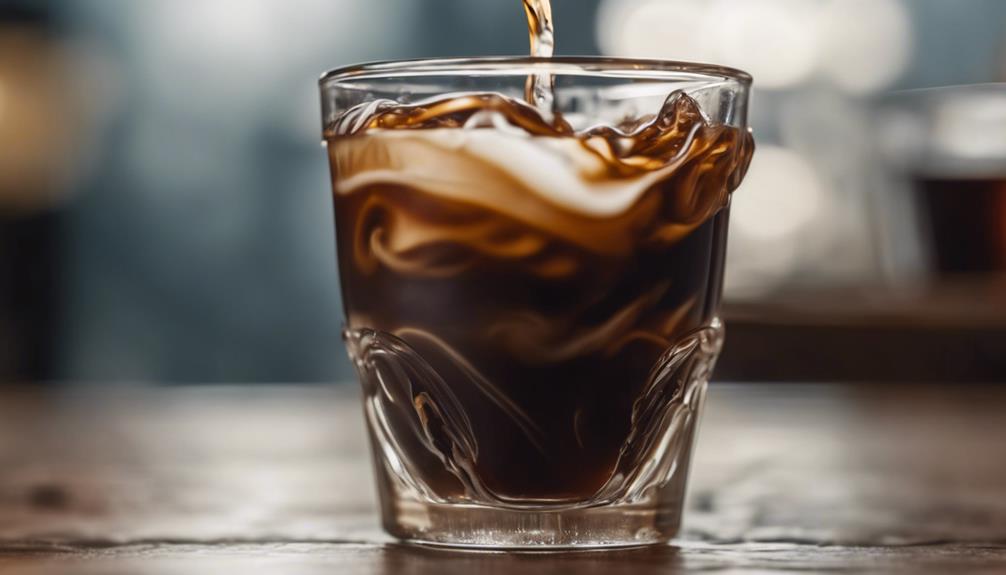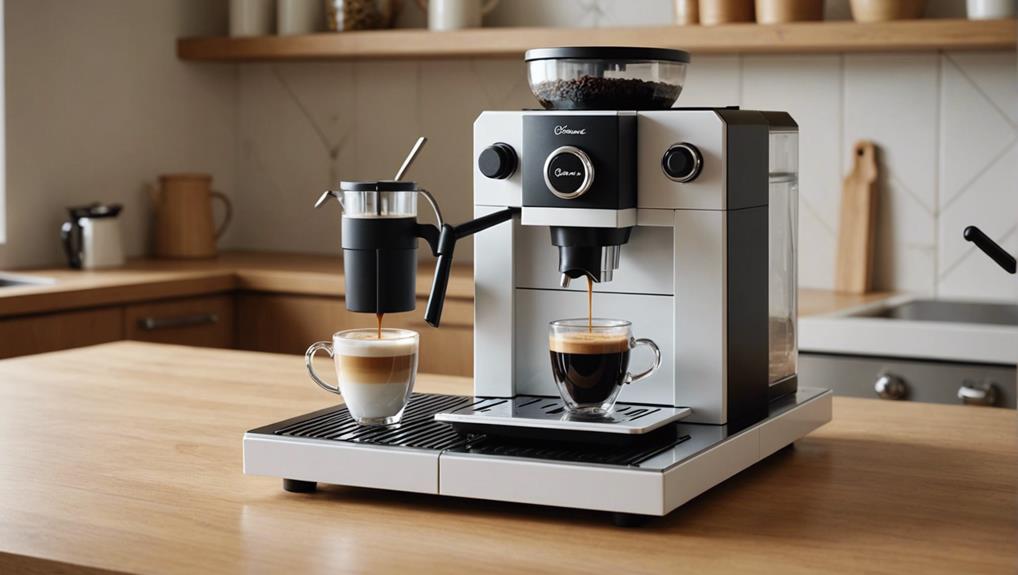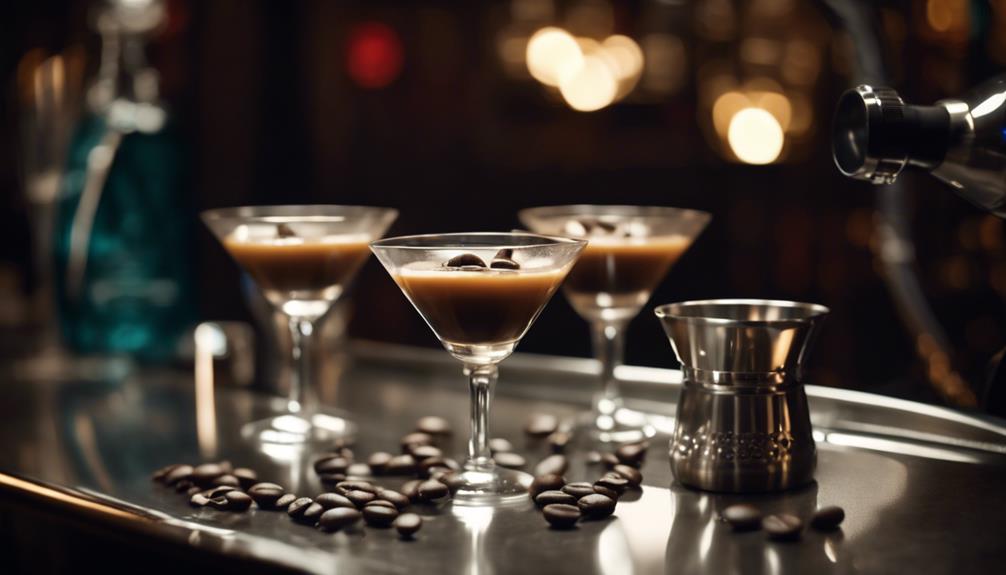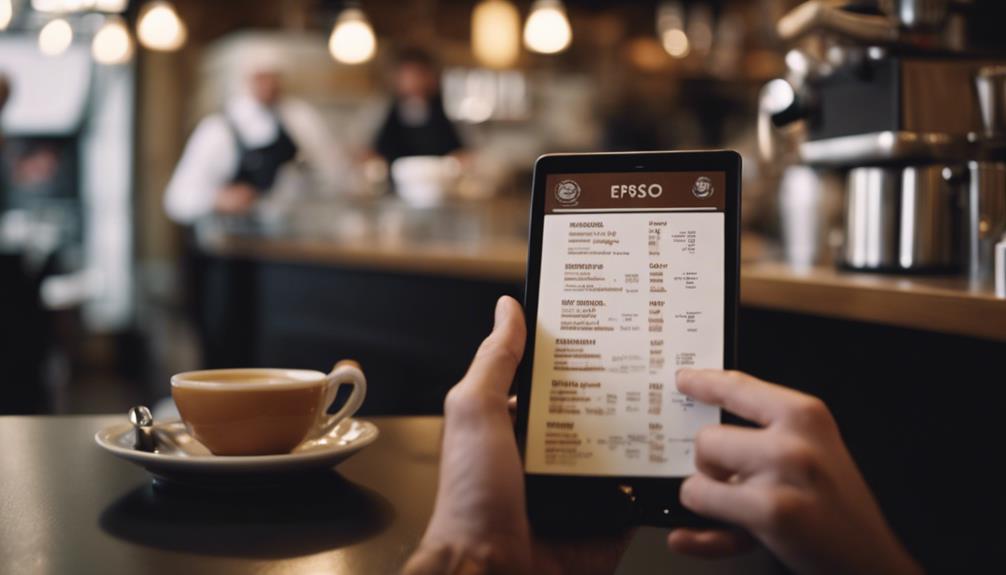To achieve the ideal cold brew, target a coffee-to-water ratio of 14g per 100ml for a double shot or 11g per 30ml for a well-balanced flavor. This will result in an espresso shot equivalent of approximately 30ml concentrate. You can fine-tune the taste intensity by adjusting the shot quantity. Play around with brewing times and grind sizes to personalize the strength and flavor. To ensure a harmonious blend, strive for brewing consistency. Additional tips can help you perfect your cold brew experience.
Key Takeaways
- Aim for a 1:7 coffee-to-water ratio (14g coffee per 100ml water) for a double shot equivalent.
- Consider 11g of coffee per 30ml water for a concentrated brew.
- Adjust shot quantity for flavor intensity and caffeine content.
- Experiment with ratios based on personal taste preferences.
- Dilute shots with water to customize strength and flavor.
Importance of Ratios in Cold Brew
Understanding the significance of ratios in cold brew is essential for crafting the perfect espresso shot. When making iced coffee, the ratio of coffee to water plays a vital role in determining the strength and flavor of your brew.
For cold brew concentrate, a common guideline is using 14g of coffee for every 100ml of water to achieve a double shot of espresso. This ratio guarantees a concentrated form of cold brew that results in a robust coffee flavor. To balance the taste, some opt for a ratio of 11g of coffee per 30ml of water when making cold brew concentrate.
Understanding Espresso Shot Equivalent
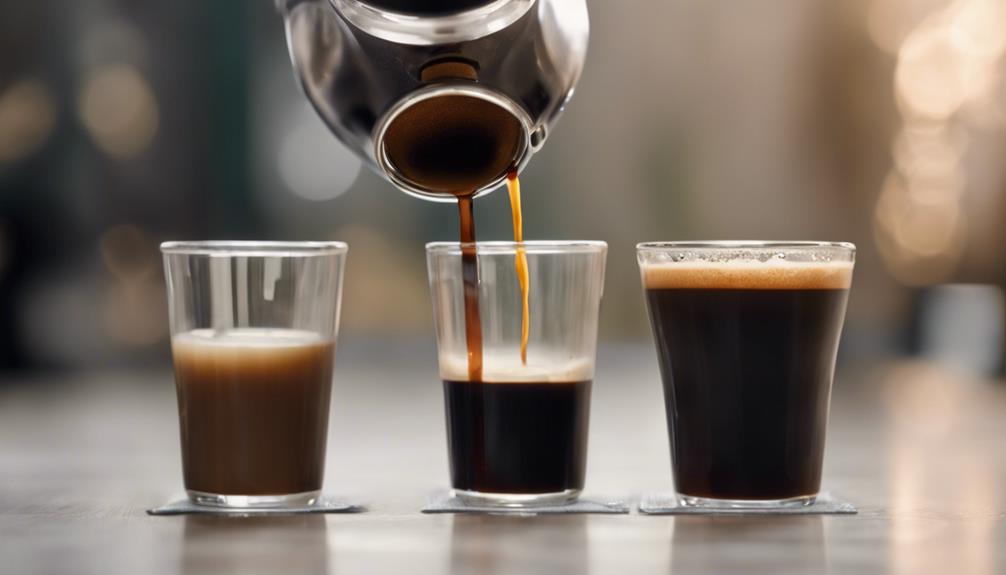
To grasp the concept of an espresso shot equivalent in cold brew, consider the concentrated caffeine boost and robust flavor it offers compared to regular cold brew. Here are some key aspects to understand about the espresso shot equivalent:
- The espresso shot equivalent in cold brew is typically around 30ml of concentrated cold brew.
- Achieving this concentration involves using a cold brew ratio of 14g of coffee per 100ml of water.
- Cold brew concentrate is stronger than regular cold brew and is often diluted before consumption to suit individual preferences.
- The espresso shot equivalent provides a potent caffeine kick and a rich, intense flavor profile.
- Understanding this equivalent helps you tailor your cold brew to match your desired caffeine intake, ensuring a satisfying and invigorating drink experience.
Calculating Coffee Grounds for Cold Brew

Calculating the ideal amount of coffee grounds for your cold brew involves precise measurement and adjusting ratios to meet your taste preferences effectively.
When preparing your cold brew concentrate, start by considering the standard ratio of 14g of coffee grounds for every 100ml of water. This ratio provides a strong base that can later be diluted to achieve the desired strength.
Alternatively, a general rule suggests using 11g of coffee grounds per 30ml of water for a concentrated brew. Keep in mind that these are starting points, and personal preferences play a significant role in determining the ideal amount of coffee beans to use.
Experiment with different ratios and adjust based on the strength and flavor profile you prefer. Remember, accuracy in measuring the coffee beans is essential to ensuring a consistent and balanced cold brew concentrate.
Water-to-Coffee Ratio Guidelines

When determining the water-to-coffee ratio for your cold brew concentrate, focus on achieving the ideal balance to extract the desired flavors and caffeine strength. Here are some guidelines to help you find the perfect ratio:
- Aim for a common ratio of 14g of coffee per 100ml of water to create a double shot of cold brew concentrate.
- Consider using 11g of coffee per 30ml of water for a more concentrated caffeine boost.
- To balance flavor and caffeine intensity, dilute your cold brew concentrate with water in a 1:3 ratio.
- Adjust the strength of your cold brew concentrate based on personal preference and desired potency.
- Experiment with different ratios and dilutions to discover the ideal espresso shot equivalent in your cold brew concentrate.
Impact of Shot Quantity on Flavor

Adjusting the number of espresso shots in your cold brew can greatly impact its flavor profile.
By increasing the shot quantity, you can enhance the intensity and richness of the taste while also boosting the caffeine content.
This customization allows you to explore the balance of flavor intensity, aroma enhancement potential, and texture to create a cold brew that suits your preferences perfectly.
Flavor Intensity Balance
To achieve a balanced flavor intensity in your cold brew, consider how the quantity of espresso shots impacts the overall taste profile. Adjusting the number of shots can greatly influence the taste experience, allowing you to tailor the cold brew to your liking.
Here are some key points to keep in mind regarding flavor intensity balance:
- Increasing the number of espresso shots can intensify the flavor profile and caffeine content, providing a more robust coffee experience.
- Doubling the espresso shot quantity in cold brew can lead to a richer and bolder taste, enhancing the overall depth of flavor.
- Experimenting with different shot quantities allows for customizing the strength of the cold brew to match your preferences.
- Elevating the complexity of flavors in cold brew is possible by increasing shot quantity, offering a more nuanced and enjoyable drinking experience.
- Finding the right balance of shot quantity can help achieve the desired taste profile, ensuring a harmonious blend of flavors in your cold brew.
Aroma Enhancement Potential
Enhancing the aroma of your cold brew can be achieved by strategically varying the quantity of espresso shots used in the brewing process. By increasing the number of espresso shots, you can create a more robust and complex flavor profile, intensifying the coffee's characteristics and adding depth and intensity to your cold brew.
This customization allows for a tailored taste experience based on your preferences, as different shot quantities impact the overall flavor and strength of the beverage. Experimenting with shot ratios not only enhances aroma but also helps find the perfect balance between caffeine content and flavor intensity in your cold brew.
The number of espresso shots used plays a significant role in influencing the richness and overall aroma of your final cold brew, making it a key factor to take into account when aiming for a specific flavor profile.
Texture and Body
By incorporating varying quantities of espresso shots into your cold brew, you can directly influence the texture and body of the resulting beverage. Here's how shot quantity impacts the flavor:
- Increasing the number of espresso shots in cold brew can enhance the texture, body, and overall flavor profile.
- A higher shot quantity can provide a richer mouthfeel and more pronounced coffee notes in cold brew.
- Experimenting with different shot ratios allows for customization of the cold brew's taste and intensity.
- The number of shots impacts the caffeine content and strength of the cold brew, influencing its energy-boosting effects.
- Balancing shot quantity with dilution is key to achieving the perfect cold brew consistency and caffeine level.
Understanding how the shot quantity affects the texture and body of your cold brew can help you tailor your brewing process to achieve the desired flavor profile and caffeine strength.
Adjusting Caffeine Levels in Cold Brew
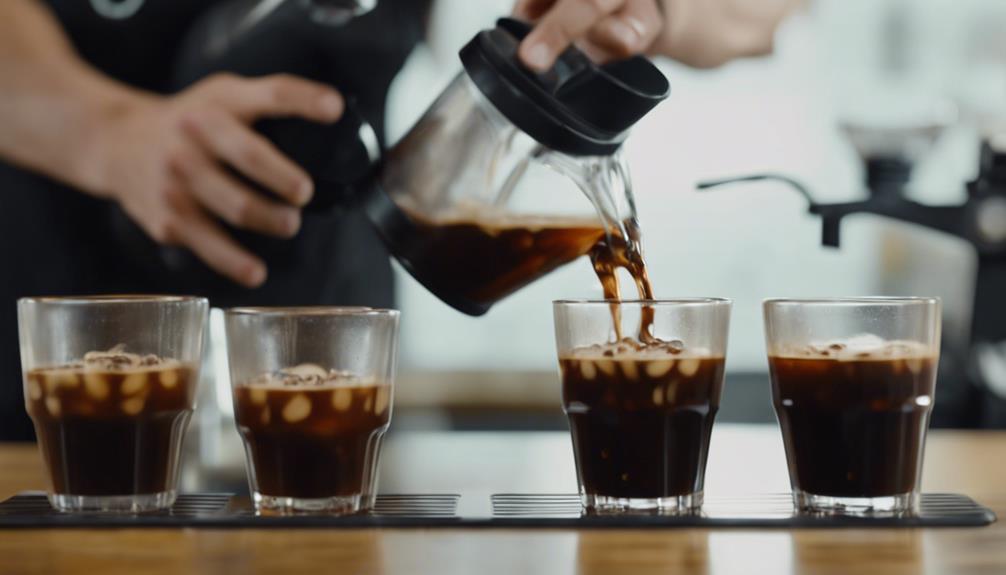
Adjusting caffeine levels in cold brew can be effectively achieved by modifying the coffee-to-water ratio during the brewing process. If you're looking for a potent caffeine punch, try increasing the amount of coffee grounds used in your cold brew recipe. By opting for a higher coffee-to-water ratio, like 1:5, you can create a brew with a stronger kick of caffeine.
Experimenting with different ratios allows you to fine-tune the caffeine level to match your taste preferences and energy needs. Keep in mind that factors such as the type of beans, grind size, and brewing time can also impact the caffeine content in your cold brew. So, don't be afraid to play around with these variables to find the perfect balance for your ideal cold brew experience.
Adjusting caffeine levels in your cold brew can provide you with a customized brew that caters to your caffeine cravings and energy requirements.
Achieving Consistency in Brewing

To achieve consistency in brewing cold brew espresso shots, make sure you use a precise ratio of coffee to water. Here are some key points to take into account:
- Stick to a specific ratio, such as 14g of coffee per 100ml of water for a double shot, to maintain consistency in your brewing process.
- For cold brew concentrate, try a ratio like 11g of coffee per 30ml of water to guarantee your brew is concentrated yet balanced.
- Adjusting the coffee to water ratio gives you control over the strength of your cold brew espresso shots, allowing you to customize them to your preferences.
- Using a consistent ratio not only aids in achieving the desired flavor profile but also ensures that each shot contains the expected caffeine content.
- Remember, precision in your coffee to water ratio is the key to replicating the same great-tasting cold brew espresso shots every time you brew.
Experimenting With Shot Numbers
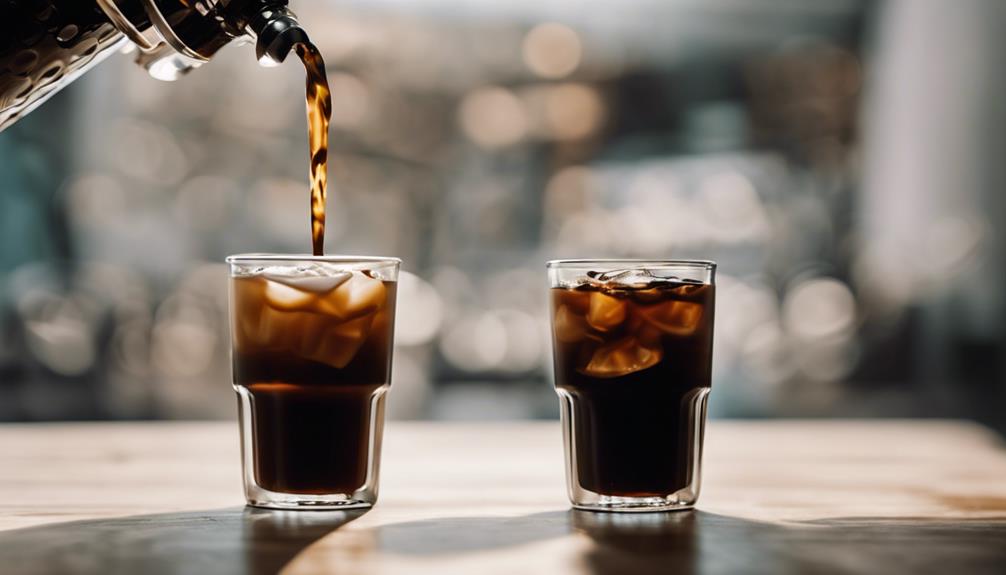
Experimenting with the number of shots in your cold brew can greatly alter the strength and flavor profile of your drink. By adjusting the shot numbers, you can customize your cold brew to suit your preferences and caffeine needs. Here's a table to illustrate how different shot numbers can impact your cold brew:
| Shots | Strength | Flavor Profile |
|---|---|---|
| 1 | Mild | Light and subtle |
| 2 | Medium | Balanced and flavorful |
| 3 | Strong | Bold and intense |
Increasing the number of shots can result in a more concentrated and potent cold brew, perfect for those who enjoy a robust flavor. On the other hand, decreasing the number of shots can lead to a milder and less intense cold brew experience, ideal for those who prefer a lighter taste. Experiment with different shot numbers to find the perfect balance of strength and flavor that suits your taste buds.
Factors Influencing Shot Ratios
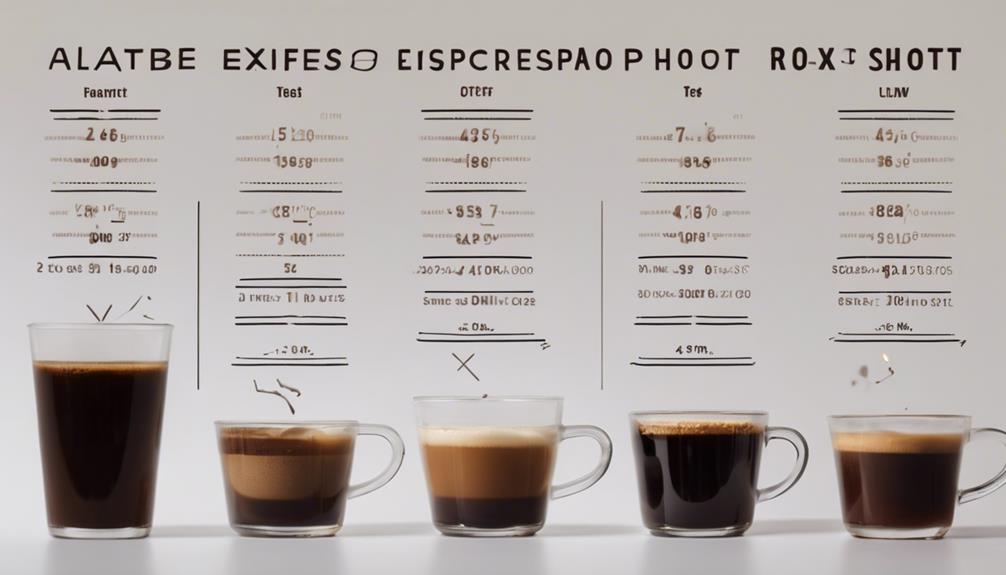
Factors influencing shot ratios in cold brew:
- The brewing temperature impact
- Coffee bean grind
- Extraction time influence
Adjusting these variables can greatly alter the strength and flavor profile of your cold brew.
Understanding how these factors interact will help you fine-tune your cold brew to achieve the perfect balance of taste and caffeine potency.
Brewing Temperature Impact
Brewing temperature significantly influences the rate of caffeine extraction in the cold brew process. When considering the impact of temperature on your cold brew shot ratio, keep in mind the following key points:
- Lower temperatures during cold brewing can lead to a smoother, less acidic flavor profile, which may affect the overall taste of your espresso shots.
- Factors such as steeping time and grind size can interact with brewing temperature to influence the best shot ratio in cold brew, highlighting the need for balance in these variables.
- The variation in cold brew shot ratios can be influenced by the desired strength and intensity of the coffee, with higher temperatures potentially yielding a more potent brew.
- Experimenting with different brewing temperatures is essential in determining the ideal shot ratio for cold brew espresso, allowing you to fine-tune your brewing process to achieve the desired flavor profile.
- Understanding how brewing temperature impacts caffeine extraction is essential for mastering the art of cold brew espresso.
Coffee Bean Grind
Achieving the ideal shot ratio for cold brew espresso heavily relies on the grind size of your coffee beans. The grind size plays an essential role in determining the flavor, caffeine content, and overall quality of your espresso shots.
When it comes to cold brew, finer grind sizes increase the surface area for extraction, resulting in a more robust flavor profile and higher caffeine levels. On the other hand, using coarser grinds may lead to under-extraction, resulting in a lighter taste and lower caffeine content in your cold brew espresso.
Consistency in grind size is key to achieving a balanced extraction and obtaining the desired shot ratios. By experimenting with different grind sizes, you can customize your cold brew espresso shots to suit your personal preferences.
Extraction Time Influence
When contemplating the perfect shot ratio for cold brew espresso, one key aspect to explore is how extraction time influences the overall flavor and caffeine content of your brew.
Here are some key points to ponder regarding extraction time influence:
- Longer extraction times can result in a higher caffeine content per shot, making your brew more potent.
- Various factors like grind size, temperature, and bean type play a role in determining the best extraction time for a balanced shot ratio.
- Beware of over-extraction as it can lead to a bitter taste, impacting the desired shot ratio.
- Shot ratios in cold brew can vary based on personal preferences for caffeine strength and flavor intensity.
- Experimenting with different extraction times allows you to fine-tune the shot ratio to create a customized cold brew experience tailored to your liking.
Personalizing Your Cold Brew Experience
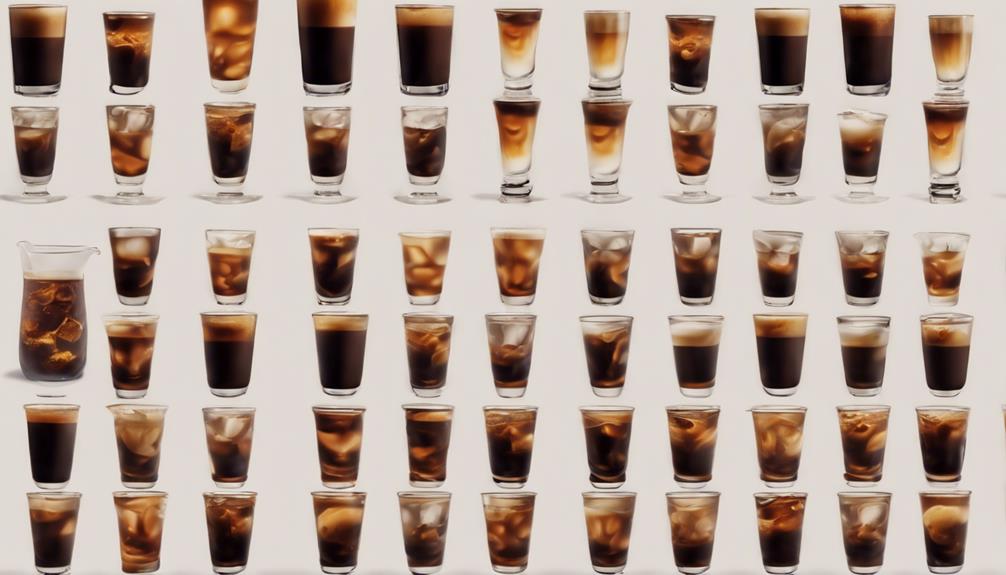
To personalize your cold brew experience, adjust the coffee-to-water ratio to suit your caffeine preferences. By tweaking this ratio, you can control the strength of your cold brew shots.
Experiment with different brewing times and grind sizes to further tailor the flavor profile to your liking. Consistency is key, so make sure to use a reliable measuring system to guarantee each batch maintains a balanced taste.
If you're looking for an extra kick, consider trying a double shot of cold brew concentrate for a more potent caffeine boost.
For those who enjoy variety, customize your cold brew shots by diluting them with water or milk to create your preferred coffee style. Whether you prefer a strong, bold flavor or a smoother, milder taste, adjusting these factors allows you to craft a cold brew experience that perfectly suits your palate.
Take the time to explore these options and find the combination that makes your cold brew truly yours.
Frequently Asked Questions
How Many Shots of Espresso Is Cold Brew?
In cold brew, the number of shots of espresso isn't a direct comparison. Cold brew typically uses a coffee-to-water ratio of 14g per 100ml, akin to a double shot of espresso.
Adjusting this ratio can customize caffeine intensity and flavor. Cold brew offers a smoother, less acidic taste than espresso. It's not about shots but about the concentration achieved through the brewing process.
Experimenting with ratios can help tailor your cold brew to your liking.
What Is the Golden Ratio for Cold Brew?
When making cold brew, the golden ratio is typically 14g of coffee for every 100ml of water for a double shot. This ratio guarantees a balanced and flavorful extraction.
For a stronger base, use 11g of coffee per 30ml of water to create a concentrate. Dilute this concentrate with a 1:3 ratio of water for a smoother taste.
Cold brew's lower acidity allows for higher consumption without the jitters, preserving delicate flavor compounds for a pleasant experience.
Is 4 Espresso Shots Too Many?
Taking into account four espresso shots in cold brew could be excessive due to the high caffeine concentration. The intense extraction from espresso might lead to a jittery experience. Finding the right espresso shot ratio is crucial for balancing flavor and caffeine levels.
Adjusting the number of shots can cater to your caffeine preferences and taste. Multiple espresso shots can provide a strong kick but may not suit those sensitive to caffeine. It's imperative to ponder your tolerance and flavor preferences.
What Is the Best Ratio for Espresso Shots?
For the best ratio of espresso shots in cold brew, aim for a balanced 1:14 ratio of coffee grounds to water. This proportion creates a strong and concentrated cold brew base that can be adjusted to suit your taste preferences.
Experimenting with different ratios allows you to customize the caffeine content and flavor intensity of your cold brew. Finding the right balance guarantees a satisfying and flavorful cold brew experience.
What is the Recommended Espresso Shot Ratio for Cold Brew?
When making cold brew, the recommended espresso shot ratio is 1:8, using 1 ounce of espresso for every 8 ounces of water. This creates a concentrated coffee base that can be diluted with milk or water. For best results, let the espresso shots per day steep in the water for 12-24 hours before straining.
Conclusion
In the world of cold brew, the perfect espresso shot ratio can make all the difference in your brewing experience. Experimenting with different shot numbers can help you achieve the ideal balance of flavor and consistency in your coffee.
By understanding the impact of shot quantities and personalizing your brewing process, you can create a cold brew that's tailored to your preferences and tastes.
So go ahead, grab your espresso shots and start brewing your perfect cold brew today.
